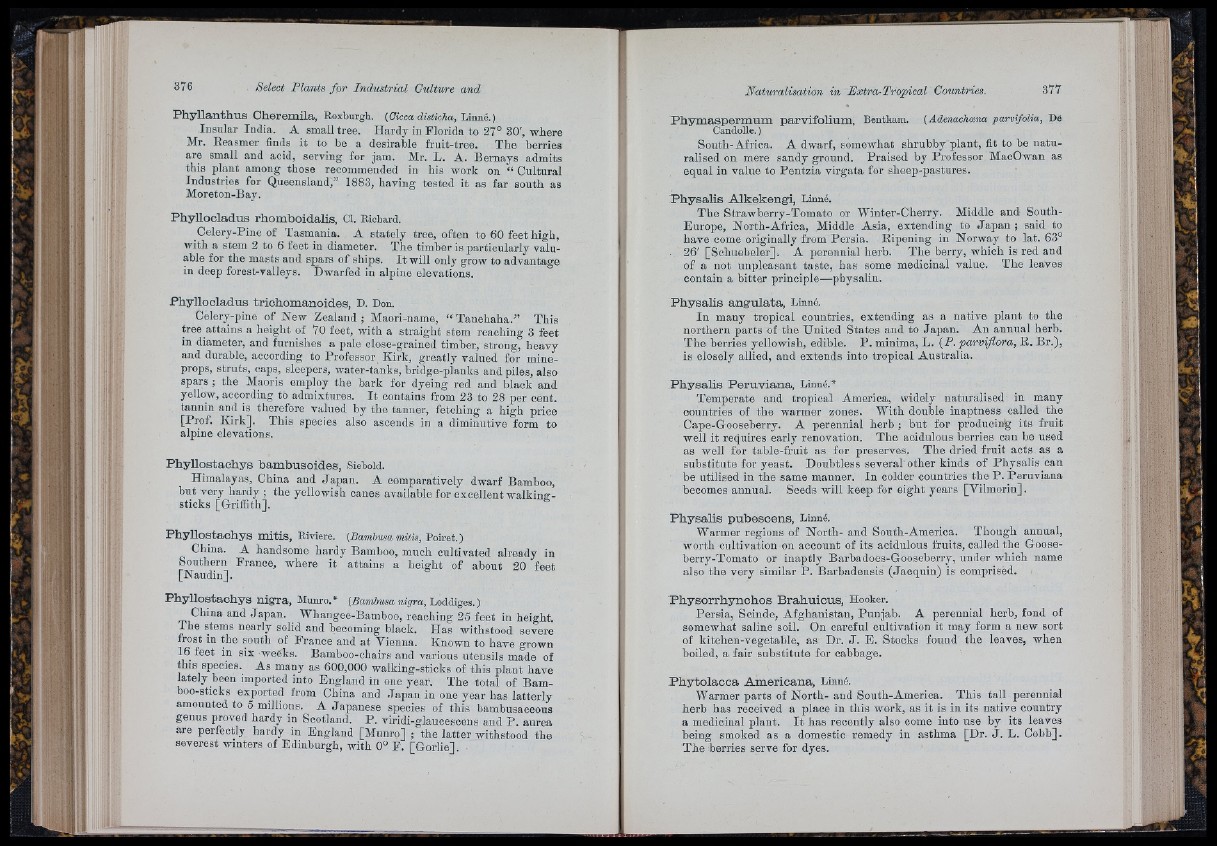
n
li'.;
’¡r
•'¡•"I lï Jf
iL
Phyllanthus Oheremila, Roxburgh. (Gicca distieha, Linne.)
Insular India. A small tree. Hardy in Florida to 27° 30', where
Mr. Reasmer finds it to be a desirable fruit-tree. The berries
are small and acid, serving for jam. Mr. L. A. Bernays admits
this plant among those recommended in his work on “ Cultural
Industries for Queensland,” 1883, having tested it as far south as
Moreton-Bay.
Phyllooladus rhomboidalis, Cl. Richard.
Celery-Pine of Tasmania. A stately tree, often to 60 feet high,
with a stem 2 to 6 feet in diameter. The timber is particularly valuable
for the masts and spars of ships. I t will only grow to advantage
in deep forest-valleys. Dwarfed in alpine elevations.
Phyllooladus triohomanoides, D. Don.
Celery-pine of New Zealand; Maori-name, “ Tanehaha.” This
tree attains a height of 70 feet, with a straight stem reaching 3 feet
in diameter, and furnishes a pale close-grained timber, strong, heavy
and durable, according to Professor Kirk, greatly valued for mine-
props, struts, caps, sleepers, water-tauks, bridge-planks and piles, also
spars ; the Maoris employ the bark for dyeing red and black and
yellow, aecording to admixtures. I t contains from 23 to 28 per cent,
tannin and is therefore valued by the tanner, fetching a high price
[Prof. Kirk]. This species also ascends in a diminutive form to
alpine elevations.
PhyBostachys bambusoides, Siebold.
Himalayas, China and Japan. A comparatively dwarf Bamboo,
but very hardy ; the yellowish canes available for excellent w alkine-
sticks [Griffith].
PhyBostachys mitis, Riviere. {Bambusa mitis, Poiret.)
China. A handsome hardy Bamboo, much cultivated already in
Southern France, where it attains a height of about 20 feet
[Naudin].
PhyBostachys nigra, Munro.* {Bambusa nigra, Loddiges.)
China and Japan. Whangee-Bamboo, reaching 25 feet in height.
The stems nearly solid and becoming black. Has withstood severe
frost in the south of France and at Vienna. Known to have grown
16 feet in six weeks. Bamboo-chairs and various utensils made of
this species. As many as 600,000 walking-sticks of this plant have
lately been imported into England in one year. The total of Bam-
boo-sticks exported from China and Jap an in one year has latterly
amounted to 5 millions. A Japanese species of this bambusaceous
genus proved hardy iu Scotland. P . viridi-glaucesceus and P . aurea
are perfectly hardy in England [Munro] ; the latter withstood the
severest winters of Edinburgh, with 0° F. [G o rlie ].
377
Phymaspermum parvifoBum, Bentham. (Adenachcena parvifolia, De
Candolle.)
South-Africa. A dwarf, somewhat shrubby plant, fit to be naturalised
on mere sandy ground. Praised by Professor MacOwan as
equal in value to Pentzia virgata for sheep-pastures.
Physalis Alkekengi, Linné.
The Strawberry-'Tomato or Winter-Cherry. Middle and South-
Europe, North-Africa, Middle Asia, extending to J a p a n ; said to
have come originally from Persia. Ripening in Norway to lat. 63°
26' [Schuebeler]. A perennial herb. The berry, which is red and
of a not unpleasant taste, has some medicinal value. 'The leaves
contain a bitter principle—physalin.
Physalis angulata, Linné.
In many tropical countries, extending as a native plant to the
northern parts of the United States and to Japan. An annual herb.
'The berries yellowish, edible. P . minima, L. (P. parviflora, R. Br.),
is closely allied, and extends into tropical Australia.
Physalis Peruviana, Linné.*
'Temperate and tropical America, widely naturalised in many
countries of the warmer zones. With double inaptness called the
Cape-Gooseberry. A perennial herb ; but for producing its fruit
well it requires early renovation. The acidulous berries can be used
as well for table-fruit as for preserves. The dried fruit acts as a
substitute for yeast. Doubtless several' other kinds of Physalis can
he utilised in the same manner. In colder countries the P. Peruviana
becomes annual. Seeds will keep for eight years [Vilmorin].
Physalis pubescens, Linné.
W'armer regions of North- and South-America. Though annual,
worth cultivation on account of its acidulous fruits, called the Goose-
berry-'Tomato or inaptly Barbadoes-Gooseberry, under which name
also the very similar P. Barbadensis (Jacquin) is comprised.
Physorrhynchos Brahuicus, Hooker.
Persia, Scinde, Afghanistan, Punjab. A perennial herb, fond of
somewhat saline soil. On careful cultivation it may form a new sort
of kitchen-vegetable, as Dr. J . E. Stocks found the leaves, when
boiled, a fair substitute for cabbage.
Phytolacca Americana, Linné.
Warmer parts of North- and South-America. This tall perennial
herb has received a place in this work, as it is in its native country
a medicinal plant. I t has recently also come into use by its leaves
being smoked as a domestic remedy in asthma [Dr. J . L. Cobb].
The berries serve for dyes.
S' '
11
I ,